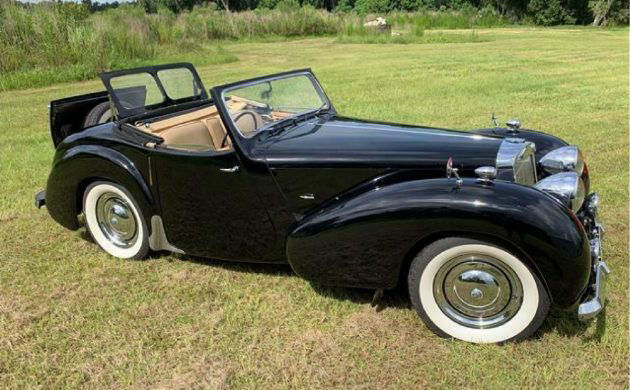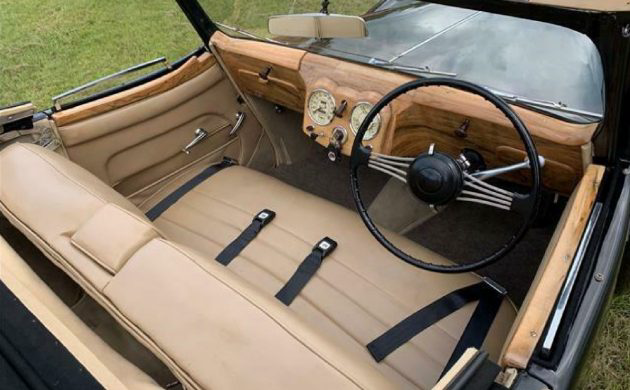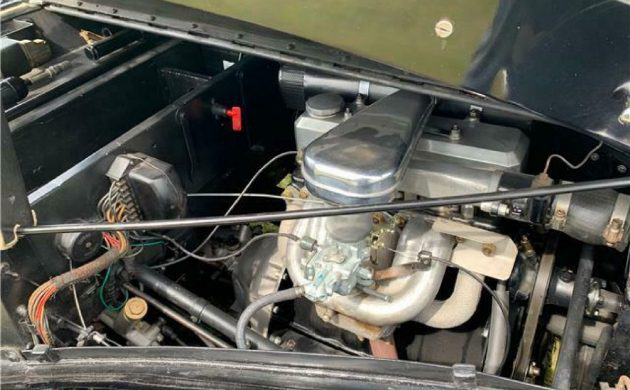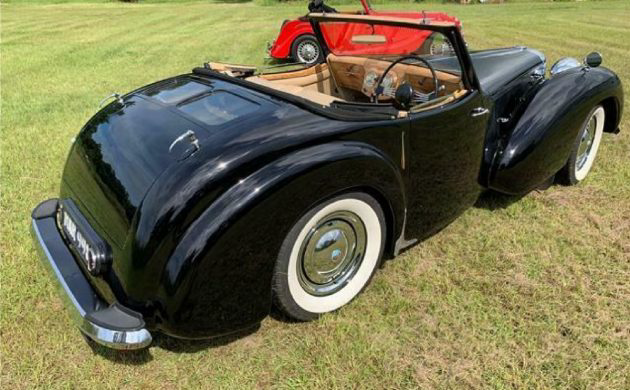Over the past decade, we have featured literally thousands of classic cars here at Barn Finds. It would be fair to say that British sports cars have received a strong representation, but I admit that this 1946 Triumph 1800 Roadster had me scratching my head. The reason is that I struggled to remember seeing one gracing our pages. I scanned through our history to discover that this is only the fifth example we’ve seen in ten years, which is in keeping with the model’s relative rarity. The previous examples have all required some form of restoration, but this car is spotlessly clean and ready to be enjoyed by its next owner. The Roadster is located in East Palatka, Florida, and has been listed for sale here on eBay. The owner has set a BIN of $69,500, but the option is available to make an offer.
Like so many areas of the country, the British automotive industry was in a sad and sorry state following World War II. Hostile forces had bombed much of the country into oblivion, and it would take decades for the country to recover from those ravages. Today, it is hard to comprehend that items like fuel, butter, and bacon, commodities that we now consider staples, were heavily rationed for many years as the country dragged itself back onto its feet. However, the British people are nothing if not resilient, and the automotive industry demonstrated this characteristic perfectly. Manufacturers thought laterally in their quest to produce cars that would not only serve to get the population mobile once again but could be exported in sufficient numbers to generate sorely-needed foreign revenue. Against this backdrop, the country produced a swathe of small and affordable sports cars for which the American buying public was happy to hand over their cash. One of the lesser-known vehicles was the Triumph 1800 because it was only produced in very limited numbers. This was partly because, unlike many of its contemporaries, it proved to be a labor-intensive vehicle that was not as cheap as the competition. The frame for each car was hand-welded from tubular steel, while the general shortage of that material meant that the panels were rubber-pressed from aluminum. Triumph had a ready supply of this material, and the presses that they utilized had seen service producing panels for the Mosquito bomber. It was a classic case of using what was available and adapting existing technologies to a new purpose. This 1948 Triumph features all of that thinking, and it presents superbly. The owner indicates that it has received a past repaint in its original shade of Black, and it still retains a winning shine. The panels are extremely straight, while the trim and glass shine as impressively as the rest of the exterior. This photo also clearly exposes one of the quirky design features of the Triumph 1800. Most British roadsters from this period were two-seaters, but Triumph introduced a level of practicality with this model. It features a rumble seat, referred to in the home country as a “dickey seat.” This feature made the 1800 a genuine four-seater, but rear passenger comfort was also considered essential. The rear seats received their own windshield to assist in this area, which folded flush with the surrounding bodywork when not in use. It might be quirky, but I will guarantee those rear passengers would’ve found this to be a welcome feature as they sped along the road with the wind in their hair.
If the exterior of this Triumph presents superbly, the interior appears to continue that trend. A previous owner had it retrimmed in Tan leather, and there’s not much to fault with the upholstery. There is no visible wear and no evidence of physical damage. The timber dash is spotless, while the gauges are crisp and clean. The only noticeable flaw that I can spot is a control knob hanging loosely between the gauges, and I’m not sure what the story is. The seller doesn’t mention it in the listing, so it might be worth investigating that further. Apart from the seatbelts, the interior appears to be original and unmolested.
As with most British sports cars from this era, the Triumph 1800 was not blessed with mountains of power. Its 1,776cc 4-cylinder engine produced a modest 65hp, which found its way to the rear wheels via a manual transmission. Therefore, it is no surprise to discover that the journey down the ¼ mile would take a leisurely 23.2 seconds, while the vehicle would be out of breath by the time the needle was nudging 80mph. However, it could still cruise fairly effortlessly at close to 60mph, so it was capable of holding its own on the open road. For potential buyers, the news with this 1800 looks pretty positive. It has been meticulously maintained under the stewardship of its four owners, and the car comes with a collection of documentation and service records that date back to Day 1. The last owner recently treated the vehicle to some significant mechanical refurbishing work, and it is ready to hit the road with the buyer behind the wheel.
As the British automotive industry dragged itself out of the rubble, Triumph developed and produced the 1800 as a new model in record time. The first examples hit the market in 1946, barely more than a year after hostilities ended. During a two-year production run, a mere 2,501 examples rolled off the line. It isn’t clear how many found their way to the USA or how many survive today. The fact that this car is right-hand drive would suggest that it was a private import, and its condition indicates that it has been treated with care and respect throughout its life. All of this brings us to the question of the BIN and how it stacks up in the current market. The relative rarity of these classics means that they don’t come onto the market very often. NADA indicates a high retail of $40,700, while Hagerty lists a #1 car at around $48,000. As if to reinforce these figures, I found a prior listing for this car that indicates that it recently sold for $44,500. That is a long way short of the BIN in the listing. Whether that sale fell over or whether this Triumph is being flipped is unclear, but if you are considering making a play for this classic, that might give you a starting point to work from as you commence negotiating. It’s definitely a point to ponder.









How much would you have to pay someone to sit in the rumble seat?
The seats are actually very secure, and you sit well down inside. I used to take fellow students from our accommodation into Uni daily along the A3. The fastest we saw was 80 mph (downhill, in a 2000, actually 2088cc) but we started drifting so I slowed down.
There is a very active Triumph Roadster club operating it of England. I am presently restoring a 1949 Triumph 2000 Roadster (TRA 834 L)
I also have a 1949 Triumph 2000 Roadster that needs to be restored
This is so perfect for your next local “Motorcars and Tea” gathering.
Nice example. Good to see the seat belts. Just replace those whitewalls.
The question is how were the seatbelts installed ? The floors are all wood . I doubt if they would meet the legal requirements .
…wooden bolts.
Wooden floors & a body framed in wood, plus seat belts, reminds me of a problem we had back in the 1980s when Maryland regulators required all limousine companies to equip their cars with seatbelts for each passenger location. We were operating a vintage limo service with wooden framed bodies, when a state police vehicle inspection required us to install seatbelts.
A friend who was a structural engineer provided me a report that said the installation of seat belts would be dangerous and give a false sense of safety to riders, as it was impossible to add seatbelts in such a manner where they could be reasonably expected to provide the necessary safety levels as stated in the regulations. He added that if the seatbelt anchors were secured to the only solid part of the car – the steel chassis – in the event of a serious accident where the wooden body mounts failed and the body lifted off the chassis, those wearing a seatbelt could be killed when the seatbelt cut their bodies in half.
My attorney added a statement that should the state still require seatbelt installations, and if an accident resulted in injuries that were found to be compounded by the use of incorrectly installed [inspected and approved by the state] we would request the court add the state as a co-defendant.
My attorney indicated that because the state would have been considered as having “deep pockets” in regards to any court settlement, and there had been several recent “big” 7-figure settlements when extra long limousines had split in half resulting in deaths, this was a major part of their decision.
Their written decision said [and I’m condensing it for this comment] that the law said that the vehicle had to be equipped with a set of DOT approved seat belts for each passenger. They noted that each vehicle was also required to be equipped with a spare tire, jacking tools, fire extinguisher, 3 road flares and 3 reflective safety triangles.
Since none of the above parts or items were required to be affixed or attached to the vehicle, the decision required the vehicle to be equipped with the necessary number of seat belts, and could be installed in the same manner as the other safety items listed above.
So all of our vintage limousines with wooden body frames had a nicely built & finished wooden box in the trunk, equipped with a brand new set of seatbelts for each passenger [plus 1 or 2 sets, depending on how many sets we could fit in the box, just in case there were a couple of additional riders], and a copy of the state’s decision, each page laminated in plastic.
We also updated our rental agreement to indicate the limo was a vintage vehicle that was not designed for seatbelts or other common safety items, and the renter accepted this situation, promising to explain the situation to everyone who was expected to ride in said vehicle!
This whole situation was moot anyway, as we never had a single accident or claim to insurance companies. But from a legal basis, the state was satisfied we met the requirements set forth.
This is NOT a sports car – they uprated the engine to 2000cc,as they did with the saloon models.Not worth the price imho.
If I’m not mistaken, I think this model came with only a 3 speed trans, so it is seriously underpowered for use on our roads.
Can’t see what power has to do with the number of gears?Nearly all US cars had 3 speed boxes in the 30’s.I have several,from a Marquette to a Cadillac V16,and they manage perfectly well because of torque.
The 1800 used a four speed gearbox, The later model 2000 used the three speed box. Both had column mounted shifters.
Love the lines on these. I wouldn’t mind resto-modding one with a modern 4cyl and Miata drivetrain! Love the popup bug shield for the rumble seat! I know where one of these has been sitting in a barn for 30+ years. I always wanted to take a stab at getting it… don’t ask me, I wont tell! :-P
Your plans being what they are, I hope you don’t get it.
It’s a beautiful car. Automtive art. It deserves to maintained as it is. It’d be cooler IMHO to strip the body off a Miata and build a simile of this beauty onto it.
like most’a it but rear bumper’n ‘rumble seat’. Lotta wood (stain into a dark contrast for the body color)? RHD? done that for several yrs, I’m out (index finger raised above the rest, hand shaken right to left rapidly).
That “control knob hanging loosely between the gauges” works the windshield wiper blades manually if/when needed.
Meanwhile, will you annoy the heck out of that Dodge Challenger Hellcat behind you? Sure! Otherwise, these are fine cruisers, at least on a par with most 1940s and early 1950s American cars. As noted above, a good bit of torque and three speeds are fine for the highway (if not the “superhighway”).
You’re right, that small knob actually engages the windshield wiper blade – there are three of them, and the driver’s side also works the switch on the motor.
A long time ago I was walking down the street and saw a white one in a garage. Having owned a number of Triumphs from TR3’s to 6’s i had to stop and talk to the fellow. Over time we shared tools and helped each other with our Triumphs.
My sister and I got a ride in the dickie seat. It only happened once as it was difficult to get in and down right comical with the two of us trying to get out.
Don’t recall seeing any left hand drive 1800’s. The column shifter was used so they could sit three across.
I believe that the 2000 model was a three speed and the 1800 was a four. There were a number of improvements in the 2000.
I would put it in the same category as my MGTD. Not fun on the highway. Was just as fast as my ‘40 Hudson but small enough where other traffic didn’t quite know how to deal with you.
I believe you can get about 100-120 hp out of the engine using TR4 parts.
You’re thinking of the later 2000 roadsters, which used the Vanguard wet-liner engine that also evolved into the TR roadster engine.
I briefly owned a 2000. Worst car I ever had.
When I was 18 or so I thought this was as stylish as a car could get. Encountering one up close and personal took that opinion down a few pegs. The large headlights and bulbous fenders looked simply ostentatious, and the whole car looked intended to impress visually, by way of compensating for any handling or performance shortcomings, of which there are many. Contrast this to another semi-sporty saloon-based car, the original Sunbeam Alpine, and it’s no contest. The Alpine, though sporty rather than sporting, did do rather well in rallying… rather than posing in front of pubs.
The Triumph 1800 Rumbleseat convertible coupe, the only car I know of that has both a flat windshield and a split windshield on the same car!
Why do the British continue to drive on the wrong side of the road?
Simple, it is so they know where they are. On the sea ships pass each other port side (left) to port side. On land the cars pass each other right side to right side. Saves confusion
Charles II,
It’s not just the British. Last time I checked, worldwide there were more right hand drive [RHD] vehicles made every year.
Why is it the “wrong” side of the road?Other countries share our view,including Japan,India,Australia,South Africa and in fact a third of the world!
In England you don’t say “rumble” seat; it is a dicky seat. This car was known as a pseudo-sports car in its day, but an elegant and reasonably comfortable one. This one appears looks very nice indeed…but I wish those whitewall tyres (yes, in England and elsewhere it’s with a “y”) were to be removed and turned around so that they face inside.
The write-up suggests that GB was bombed to smitereens in WW2; good propaganda for the uninitiated. The bombing they suffered was – in the context of the times – a little more than a nuisance especially considering the opponents did not have any long distance heavy bombers to speak of never having anticipated an air war.
Staggeringly inaccurate assessment of the impact of a blitz – check out what “little more than a nuisance” looks like in the attachments below
https://www.pri.org/stories/2015-04-14/map-shows-locations-where-bombs-fell-london-during-world-war-ii
https://www.dailymail.co.uk/news/article-2016667/Colour-pictures-revealed-London-blitz-Nazi-bombers-World-War-II.html
Gerard: the destruction of Britain was severe. It took three decades to totally rebuild. My mother’s house was destroyed during the very first air raid. Then her second house… and then her third (thank God for air raid shelters). Apart from the bombers, which didn’t have far to fly from their French bases, you had V-1 “doodlebugs”. V-2 rockets would devastate entire blocks/streets… All of this was a bit more than just “a nuisance”.
Well said!Coventry was all but obliterated,London was badly hit,as were Liverpool and many of the major cities.Mind you.as Bomber Harris said “you sowed the wind,now reap the whirlwind”(courtesy of the RAF).
God bless you folks for speaking up…To equate this to being no big deal is absurd. I will chalk it up to ignorance, just the same very sad.
The more I think about it, the more inane, insulting & ignorant Gerard’s comments are. The “opponents” (it’s not a bloody hockey game) were hell bent on world domination. They didn’t need long distance bombers as they’d invaded France – the distance between UK (my country) and France is a 21 mile sea channel.
40,000 people killed & 1m homes destroyed in London in 1940/41. 70,000 killed by bombing in 6 years of war.
Some “nuisance”, eh?
I buy into the “no personal attacks” rule as 100% correct, but it’s tempting when the writer is a blithering idiot who has no knowledge of which he speaks.
Very smart looking car. Not too sure about the asking price though. I think there was a later version with a waterfall grille, very similar to a 1937 Hudson.
Wayne, you’re thinking of the earlier Dolomite.
https://en.wikipedia.org/wiki/Triumph_Dolomite_(1934%E2%80%931940)#/media/File:Triumph_Dolomite_roadster_coup%C3%A9_1940_-_front.jpg
Andrew, thanks, yes that’s the one. Cheers
Nice looking Roadster, But something is messed up with the VIN ? the correct # should be TRD then a 3 or 4 digit number. This number is located on a round brass disc attached to the right side of the scuttle.
Steve,
The chassis disc can be seen in one of the photos, but not clearly enough to read the VIN. So chances are that the VIN was not correctly written down or read, or entered correctly in the listing.
Considering the ebay listing indicates the car has all of it’s original paperwork and service records from “day one”, I would think the VIN will be correct on the chassis disc and title. But as the seller says, “All it takes is a call to us”.
Why can’t people like it or not like it for what it is——a 75 yr old 2/4 seater British roadster that looks cool.
You would either want to have it or not, as is.
Yes it has its flaws and drawbacks, but what vehicle doesn’t.